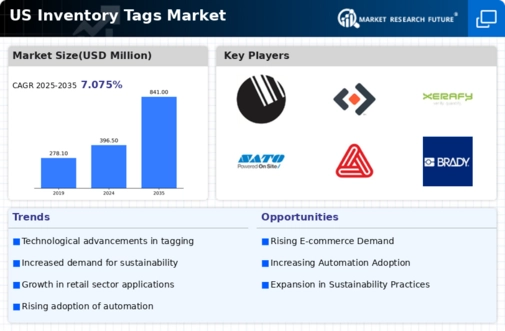Rising E-commerce Adoption
The increasing adoption of e-commerce in the US is driving the inventory tags market. As online shopping continues to grow, retailers are compelled to enhance their inventory management systems. Inventory tags play a crucial role in tracking products efficiently, ensuring that stock levels are accurate and readily available. In 2025, e-commerce sales in the US are projected to reach approximately $1 trillion, indicating a robust demand for effective inventory solutions. This surge in online retail necessitates the implementation of advanced inventory tracking technologies, thereby propelling the inventory tags market forward. Retailers are likely to invest in innovative tagging solutions to streamline operations and improve customer satisfaction, which further emphasizes the importance of inventory tags in the evolving retail landscape.
Enhanced Supply Chain Management
The need for improved supply chain management is a significant driver for the inventory tags market. Companies are increasingly recognizing the importance of real-time inventory tracking to optimize their supply chains. Inventory tags facilitate accurate data collection, enabling businesses to monitor stock levels and reduce discrepancies. In 2025, the US supply chain management market is expected to grow by over 10%, highlighting the increasing focus on efficiency and accuracy. As organizations strive to minimize costs and enhance operational efficiency, the demand for reliable inventory tagging solutions is likely to rise. This trend indicates a growing reliance on inventory tags as essential tools for effective supply chain management, ultimately benefiting the inventory tags market.
Regulatory Compliance Requirements
Regulatory compliance is becoming increasingly stringent across various industries in the US, which is positively impacting the inventory tags market. Companies are required to maintain accurate records of their inventory for compliance with safety and quality standards. Inventory tags serve as vital tools for ensuring that businesses adhere to these regulations by providing clear and traceable information about products. In sectors such as pharmaceuticals and food services, compliance with regulations can lead to significant penalties if not properly managed. As a result, the inventory tags market is likely to experience growth as organizations invest in tagging solutions to meet these compliance requirements, thereby enhancing their operational integrity.
Growing Demand for Real-time Data Analytics
The growing demand for real-time data analytics is emerging as a key driver for the inventory tags market. Businesses are increasingly relying on data-driven decision-making to enhance their operational efficiency. Inventory tags provide essential data that can be analyzed to gain insights into stock levels, turnover rates, and customer preferences. In 2025, the market for data analytics in supply chain management is anticipated to grow by over 15%, reflecting the increasing importance of real-time information. As organizations strive to optimize their inventory management processes, the need for effective tagging solutions that facilitate data collection and analysis is likely to rise. This trend indicates a promising future for the inventory tags market as businesses seek to harness the power of data.
Technological Advancements in Tagging Solutions
Technological advancements in tagging solutions are significantly influencing the inventory tags market. Innovations such as RFID (Radio Frequency Identification) and NFC (Near Field Communication) are transforming how inventory is tracked and managed. These technologies offer enhanced accuracy and efficiency compared to traditional barcode systems. In 2025, the RFID market in the US is projected to reach approximately $5 billion, indicating a strong shift towards more sophisticated inventory management solutions. As businesses seek to leverage these technologies to improve their inventory processes, the demand for advanced inventory tags is expected to rise. This trend suggests that the inventory tags market will continue to evolve, driven by the integration of cutting-edge technologies.























Leave a Comment